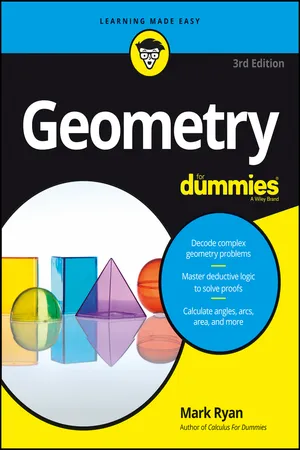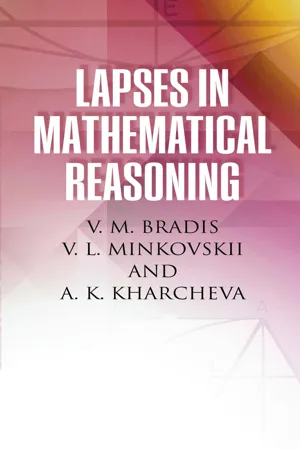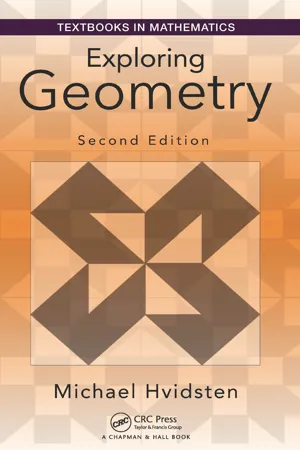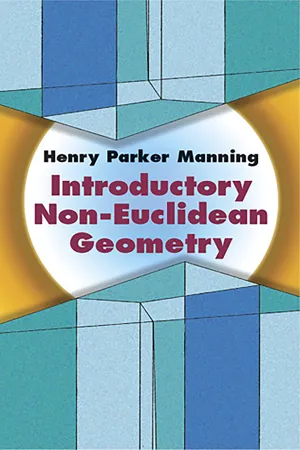Mathematics
Isosceles Triangles
Isosceles triangles are a type of triangle that has two sides of equal length. This means that two of its angles are also equal. The third side and angle of an isosceles triangle are typically unequal to the other two sides and angles.
Written by Perlego with AI-assistance
Related key terms
7 Key excerpts on "Isosceles Triangles"
- eBook - ePub
- Mark Ryan(Author)
- 2016(Publication Date)
- For Dummies(Publisher)
Part 3Triangles: Polygons of the Three-Sided Variety
IN THIS PART … Get familiar with triangle basics. Have fun with right triangles. Work on congruent triangle proofs.Passage contains an image Chapter 7
Grasping Triangle Fundamentals
IN THIS CHAPTER Looking at a triangle’s sides: Equal or unequal Uncovering the triangle inequality principle Classifying triangles by their angles Calculating the area of a triangle Finding the four “centers” of a triangleConsidering that it’s the runt of the polygon family, the triangle sure does play a big role in geometry. Triangles are one of the most important components of geometry proofs (you see triangle proofs in Chapter 9 ). They also have a great number of interesting properties that you might not expect from the simplest possible polygon. Maybe Leonardo da Vinci (1452–1519) was on to something when he said, “Simplicity is the ultimate sophistication.”In this chapter, I take you through the triangle basics — their names, sides, angles, and area. I also show you how to find the four “centers” of a triangle.Taking In a Triangle’s Sides
Triangles are classified according to the length of their sides or the measure of their angles. These classifications come in threes, just like the sides and angles themselves. That is, a triangle has three sides, and three terms describe triangles based on their sides; a triangle also has three angles, and three classifications of triangles are based on their angles. I talk about classifications based on angles in the upcoming section “Getting to Know Triangles by Their Angles .”The following are triangle classifications based on sides:- Scalene triangle: A scalene triangle is a triangle with no congruent sides
- Isosceles triangle: An isosceles triangle is a triangle with at least two congruent sides
- Equilateral triangle: A equilateral triangle is a triangle with three congruent sides
Because an equilateral triangle is also isosceles, all triangles are either scalene or isosceles. But when people call a triangle isosceles, they’re usually referring to a triangle with only two equal sides, because if the triangle had three equal sides, they’d call it equilateral. - eBook - ePub
- (Author)
- 2008(Publication Date)
- Trade Paper Press(Publisher)
similar . All circles are similar. All squares are similar. Triangles are similar if corresponding angles are equal.angles in triangles The exterior angle of a triangle is equal to the sum of the opposite interior angles.triangle types of triangle.triangle A triangle is a three-sided plane figure, the sum of whose interior angles is 180°. Triangles can be classified by the relative lengths of their sides. A scalene triangle has three sides of unequal length; an isosceles triangle has at least two equal sides; an equilateral triangle has three equal sides (and three equal angles of 60°).median The median is the name given to a line from the vertex (corner) of a triangle to the midpoint of the opposite side.A right-angled triangle has one angle of 90°. If the length of one side of a triangle is l and the perpendicular distance from that side to the opposite corner is h (the height or altitude of the triangle), its area A = lh .hypotenuse The longest side of a right-angled triangle, opposite the right angle, is the hypotenuse. It is of particular application in the Pythagorean theorem (the square of the hypotenuse equals the sum of the squares of the other two sides), and in trigonometry where the ratios sine and cosine (see under trigonometry below) are defined as the ratios opposite/hypotenuse and adjacent/hypotenuse respectively.altitude The altitude of a figure is the perpendicular distance from a vertex (corner) to the base (the side opposite the vertex).circle Technical terms used in the geometry of the circle; the area of a circle can be seen to equal πr2 by dividing the circle into segments which form a rectangle.The Pythagorean theorem
The Pythagorean theorem states that in a right-angled triangle, the area of the square on the hypotenuse (the longest side) is equal to the sum of the areas of the squares drawn on the other two sides. If the hypotenuse is h units long and the lengths of the other sides are a and b , then h 2 = a 2 + b 2 - eBook - ePub
- V. M. Bradis, L. Minkovskii, A. K. Kharcheva(Authors)
- 2016(Publication Date)
- Dover Publications(Publisher)
3 , and represent the second, third, and fourth terms of that same geometric progression.The side a may be arbitrary. But the number q is not completely arbitrary. It has to satisfy the inequality aq2 < a + aq, since the greatest side of the triangle must be less than the sum of the two other sides. Dividing both members of that inequality by a, we obtain the inequality q2 – q – 1 < 0, which has to be satisfied by the number q (consideration of the second triangle leads to the same inequality). By factoring the second degree trinomial q2 – q – 1, we rewrite this inequality in the formor in the form , and we note that the expression in the second bracket is always positive for q > 1. Consequently, the expression in the first bracket must be negative, and therefore:Thus, two similar unequal triangles have two pairs of respectively equal sides if, and only if, the sides of the first triangle are equal to a, aq, aq2 , and the sides of the second are equal to aq, aq2 , aq3 , where the side a is arbitrary and the number q is taken between 1 and .We can find any number of pairs of such triangles.64. Trisection of an angleTo carry out the trisection of an angle means to divide an angle into three equal parts. To do this is, of course, not at all difficult. We may, for example, measure the given angle with a protractor, divide the measured number of degrees by three, and then, by means of the same protractor, lay off an angle containing the quotient in degrees. We can, however, manage also without the protractor, applying the method of “successive approximation” —having constructed an arc of arbitrary radius, for which the given angle is the central angle, we lay off by eye a chord corresponding to a third part of the arc, and lay off that chord successively three times along the arc, beginning from one of its ends. If we then find ourselves on the other end of the arc, the problem is solved. If, however, as usually happens, we do not reach the other end of the arc, or pass beyond it, then the chord taken by eye has to be corrected, increasing or decreasing it by one-third of the distance from the point obtained to the end of the arc, where this one-third we take again by eye. This corrected chord is again laid off on the arc, and in case of necessity we correct it again in the same manner. Each new (corrected) chord will give an ever more exact solution and, finally, after repeating the operation a few times, we obtain a chord which will be laid off the given arc almost exactly three times, and the trisection of the angle will have been carried out. Obviously, these two methods allow us to divide the given angle not only into three but into any number of equal parts. - eBook - ePub
Military schools and courses of instruction in the science and art of war,
in France, Prussia, Austria, Russia, Sweden, Switzerland, Sardinia, England, and the United States. Drawn from recent official reports and documents. Revised Edition
- (Author)
- 2013(Publication Date)
- Perlego(Publisher)
1. OF PLANE FIGURES. Measure of the distance of two points.—Two finite right lines being given, to find their common measure, or at least their approximate ratio.Of angles.—Right, acute, obtuse angles.—Angles vertically opposite are equal.Of triangles.—Angles and sides.—The simplest cases of equality.—Elementary problems on the construction of angles and of triangles.Of perpendiculars and of oblique lines.Among all the lines that can be drawn from a given point to a given right line, the perpendicular is the shortest, and the oblique lines are longer in proportion to their divergence from the foot of the perpendicular.Properties of the isosceles triangle.—Problems on tracing perpendiculars.—Division of a given straight line into equal parts.Cases of equality of right-angled triangles.Of parallel lines.Properties of the angles formed by two parallels and a secant.—Reciprocally, when these properties exist for two right lines and a common secant, the two lines are parallel.1 —Through a given point, to draw a right line parallel to a given right line, or cutting it at a given angle.—Equality of angles having their sides parallel and their openings placed in the same direction.Sum of the angles of a triangle.The parts of parallels intercepted between parallels are equal, and reciprocally. Three parallels always divide any two right lines into proportional parts. The ratio of these parts may be incommensurable.—Application to the case in which a right line is drawn, in a triangle, parallel to one of its sides. - eBook - ePub
- Clayton W. Dodge(Author)
- 2012(Publication Date)
- Dover Publications(Publisher)
Figure 18.718.8 Theorem The base angles of an isosceles triangle are congruent.18.9 Theorem The diagonals of a parallelogram bisect each other.Let N be the midpoint of diagonal AC of parallelogram ABCD. Then σAσN= σNσC. We must show that N is the midpoint of BD; that is, that σDσN= σNσB18.10 Corollary A parallelogram is symmetric with respect to the point of intersection of its diagonals.18.11 Corollary A parallelogram and either diagonal form two congruent triangles.18.12 Theorem The perpendicular bisector of the (major) base of an isosceles trape- zoid is the perpendicular bisector also of the summit (minor base).Reflect the isosceles trapezoid ABCD in its base AB into the image trapezoid ABC′ D′ (Fig. 18.12 ). Let CC′ and DD′ cut AB at E and F. The angles at E and F are right angles and DF ≅ CE. Now AD ≅ BC is given, and AD ≅ AD′, BC ≅ BC′ and CC ≅ DD′. So Isosceles Triangles ADD′ and BCC′ are congruent. Then their corresponding altitudes AF and BE are congruent. Hence the perpendicular bisector of AB is the perpendicular bisector of EF, hence also of CD, since CDFE is a rectangle.Figure 18.1218.13 Corollarya) The base angles of an isosceles trapezoid are congruent. b) The summit angles of an isosceles trapezoid are congruent. c) The diagonals of an isosceles trapezoid are congruent. d) An isosceles trapezoid is symmetric with respect to the perpendicular bisector of its bases.18.14 Theorem If the base angles (or the summit angles) of a trapezoid are congruent, then the trapezoid is isosceles.18.15 Theorem In Fig. 18.15 , if A B ≅ B C ≅ D E, A D ≅ BE, and BD ≅ CE, then A, B, and C are collinear.Triangles ABD and BCE are congruent by SSS and BCED is a parallelogram, so BD is parallel to CE. Similarly, AD is parallel to BE. Thus there is a translation mapping triangle ADB into triangle BEC. Since a translation preserves directions of lines, it follows that A, B, and C are collinear. - eBook - ePub
- Michael Hvidsten(Author)
- 2016(Publication Date)
- Chapman and Hall/CRC(Publisher)
↔ . That is, opposite sides are parallel.Here’s the first set of exercises to work through. The tools that will prove most helpful to you include the theorems covered so far on parallels and triangle congruence.Exercise 2.4.1 .(Prop. 34 of Book I) Show that in parallelogram ABCD, opposite sides are congruent, opposite angles are congruent and the diagonal bisects the parallelogram. (That is, the diagonal divides the parallelogram into two congruent triangles.).Now that we have covered the basic properties of a parallelogram we will consider Euclid’s first analysis of how two parallelogram shapes can be compared.Prop. 35 of Book I : Two parallelograms having the same base and defined between the same parallels are equal .Euclid never defines what “equals” means, but from his proofs it is clear that it has to do with being able to dissect two figures into pairs of congruent triangles. We will define two ways of dissecting figures —one additive and one subtractive.Definition 2.20 . We will call two geometric figures P and P ′ equidecomposable or congruent by addition if it is possible to decompose each into a finite number of non-overlapping trianglesP =T 1∪ ⋯ ∪T nP ′=∪ ⋯T ′1T ′nwhere for each i, triangle Ti is congruent to.[19 , page 197 ]T ′iFor the proof of Prop. 35 of Book I , let parallelograms ABCD and EBCF be two parallelograms sharing basewithB C¯parallel toA F↔.B C↔There are two possible configurations for the parallelograms: either D will be between E and F as shown in the top configuration, or D will not be on segmentas shown in the second configuration.E F¯Exercise 2.4.2 . In the first case, where D is between E and F, use a SAS argument to show that triangles ΔEAB and ΔFDC are congruent. Then, show that these two parallelograms are congruent by addition - eBook - ePub
- Henry Parker Manning(Author)
- 2013(Publication Date)
- Dover Publications(Publisher)
3. Theorem.In a triangle with unequal angles the side opposite the greater of two angles is greater than the side opposite the smaller; and conversely, if the sides of a triangle are unequal the opposite angles are unequal, and the greater angle lies opposite the greater side.4. Theorem.If two triangles have two sides of one equal, respectively, to two sides of the other, but the included angle of the first greater than the included angle of the second, the third side of the first is greater than the third side of the second; and conversely, if two triangles have two sides of one equal, respectively, to two sides of the other, but the third side of the first greater than the third side of the second, the angle opposite the third side of the first is. greater than the angle opposite the third side of the second.5. Theorem. The sum of two lines drawn from any point to the extremities of a straight line is greater than the sum of two lines similarly drawn but included by them.6. Theorem. Through any point one perpendicular only can be drawn to a straight line.Proof. Let P′ be the position which P would take if the plane were revolved about AB into coincidence with itself. If we could have two perpendiculars, PC and PD, from P to AB, then CP′ and DP′ would be continuations of these lines and we should have two different straight lines joining P and P′, which is impossible.Corollary. Two right Triangles are equals when the hypothenuse and an acute angle of one are equal, respectively, to the hypothenuse and an acute angle of the other.7. Theorem. The perpendicular is the shortest line that can be drawn from a point to a straight line.Corollary. In a right triangle the hypothenuse is greater than either of the two sides about the right angle.8. Theorem.If oblique lines drawn . from a point in a perpendicular to a line cut off unequal distances from the foot of the perpendicular, they are unequal, and the more remote is the greater; and conversely, if two oblique lines drawn from a point in a perpendicular are unequal, the greater cuts off a greater distance from the foot of the perpendicular.
Index pages curate the most relevant extracts from our library of academic textbooks. They’ve been created using an in-house natural language model (NLM), each adding context and meaning to key research topics.






